
Please note that the above list includes the countries that have placed a ban on hijab (headscarf) and not burqa and niqab (face-covering veil).Īlso Read | Hijab Controversy: What has Karnataka High Court said?

In 2018, an Uzbek imam was sacked by the Uzbek authorities after he urged the country's President to lift a ban on religious symbols including the hijab. The government in 2012 banned the selling of religious clothing such as hijabs and face veils in the market. Hijab is banned in schools and varsities in two regions of Russia- the Republic of Mordovia and the Stavropol Territory. Some schools in Kyrgyzstan barred Muslim students donning headscarves from attending classes in 2011, 20. However, in 2014, Kosovo got its first women parliamentarian with a headscarf. Wearing of hijab in public schools, universities and government buildings is banned since 2009. A year later, the government proposed a ban on people wearing headscarves, niqabs, and other similar forms of clothes in public. Some schools banned headscarves in Kazakhastan in 2017. Being a secular nation, the country allows people to donn headscarves, turbans or other religious clothing in public. IndiaĪlthough some schools in India do not allow girls to wear hijab in classrooms, it is not banned in the country. The law, however, doesn't apply to universities. Franceįrance passed a law in 2004 banning all religious clothing and symbols in schools. Wearing religious symbols for all public servants in positions of authority in Canadian province Québec are prohibited.


 0 kommentar(er)
0 kommentar(er)
